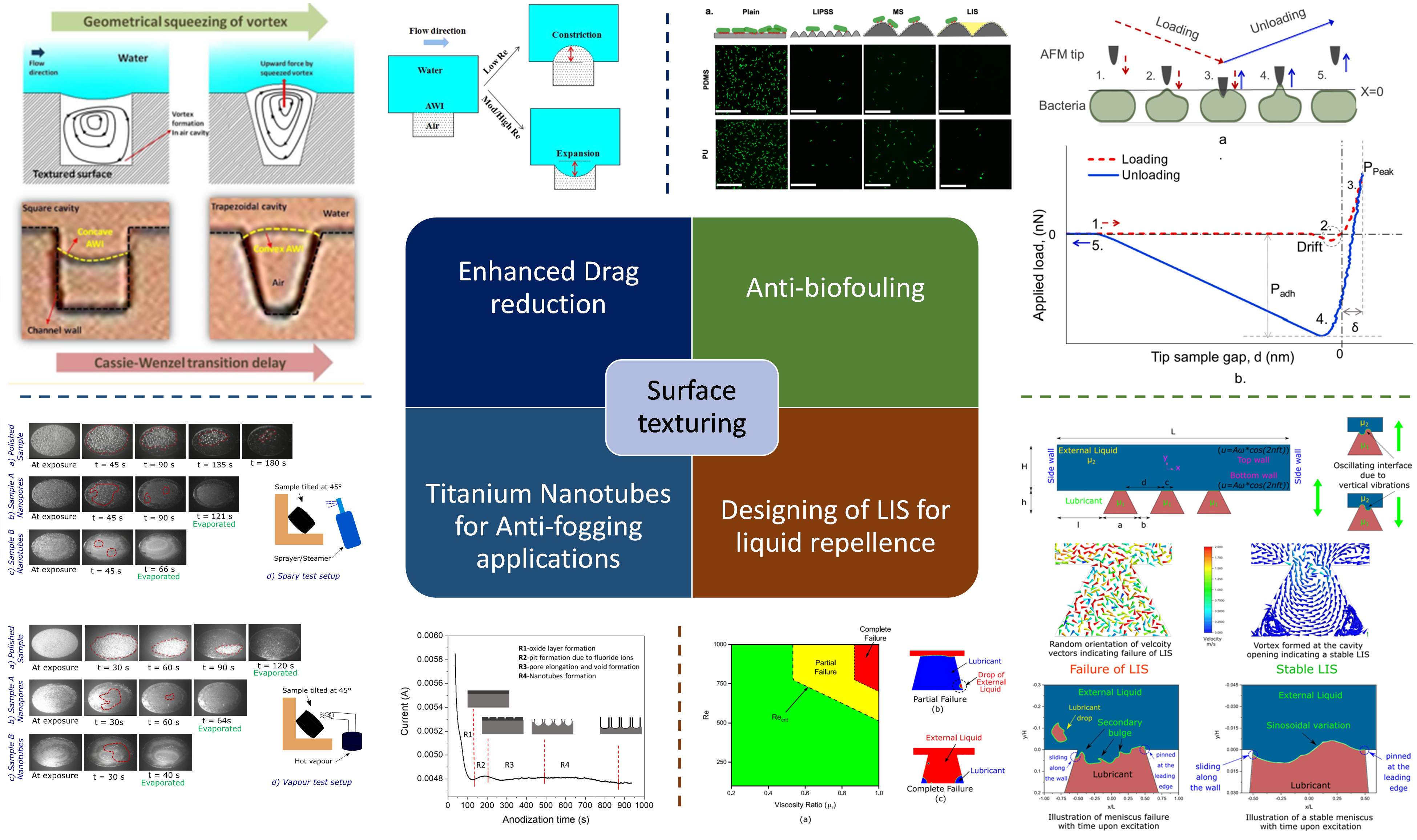
Tailoring Bio-Inspired Surfaces for Enhanced Drag Reduction, Liquid Repellence, and Anti-Biofouling Applications
Advancements in micro- and nanomanufacturing using both conventional and non-conventional techniques (such as lithography, femtosecond lasers, electro-discharge texturing, and anodization) have significantly enhanced our understanding of surface texture interactions with external liquids across various applications. Lotus leaf-inspired superhydrophobic surfaces (SHS) have demonstrated exceptional success in liquid repellence, drag reduction, and anti-biofouling. Additionally, Nepenthes pitcher plant-inspired liquid-infused surfaces (LIS) have surpassed SHS in terms of pressure stability due to the presence of an incompressible liquid within the textures. Our group's research focuses on experimentally studying the interaction of external liquids in the context of droplets, bulk flow, and bacteria, while also numerically designing the interaction of texture cavities with bulk flow and bacterial adhesion.
Enhanced Drag reduction:
This study explores how liquid-driven vortices within microchannel air cavities dissipate energy to delay the Cassie-Wenzel wetting transition. Using polydimethylsiloxane-based microchannels fabricated using lithography with various cavity shapes (square, trapezoidal, and U-shape). We identify two distinct flow regimes at different Reynolds numbers and demonstrate that trapezoidal
cavities, due to their geometry, are more effective in delaying wetting transitions than those with vertical walls. The findings are supported by numerical simulations and suggest that this passive method could be more efficient than previously studied active approaches
Anti-biofouling applications:
Our study evaluates the anti-biofouling properties of submicron topographies created on biomedical elastomer surfaces using femtosecond laser processing. The two topographies—laser-induced periodic surface structures (LIPSS) and multiscale structures (MS)—were replicated on polydimethylsiloxane (PDMS) and polyurethane (PU), significantly reducing bacterial adhesion by over 89%. The surfaces demonstrated long-term hydrophobic durability and showed comparable anti-biofouling performance to lubricant-impregnated surfaces, offering a cost-effective solution for improving the biocompatibility of polymeric biomedical components.
This research investigates the mechanical response of Escherichia coli under varying loading conditions to better design antibacterial surfaces for implants and food packaging. The study found that increasing the loading rate significantly raises bacterial modulus while reducing the adhesion force, but varying loads did not affect these properties. A rupture force of 34.38 nN was identified as a failure criterion for bacterial cell walls, and the creep response was shown to fit a standard linear solid model. These findings contribute to understanding bacteria's mechanical properties in relation to contact killing mechanisms.
Liquid infused surfaces:
Our study investigates lubricant depletion in dovetail-shaped microchannels under shear flow, focusing on lubricant-infused surfaces (LIS). The research shows that lower viscosity external liquids help retain lubricants better, and different meniscus shapes emerge based on shear flow. The findings, supported by vortex formation and interface velocities, offer insights for designing more robust LIS systems by optimizing lubricant retention.
Further, we explore the durability of lubricant-infused surfaces (LIS) during transport for food packaging applications by examining lubricant retention under oscillatory motion. The study reveals that a more viscous external liquid and denser lubricant improve LIS stability by damping vibrations, while chaotic vortex behavior leads to failure. The results provide guidance for enhancing LIS durability by preventing lubricant depletion and meniscus failure.
Titanium Nanotubes for anti-fogging applications:
In this study, we fabricated titanium nanotubes via anodization to create anti-fogging surfaces. Two surfaces were developed by varying anodization time and voltage, producing nanopores and nanotubes. The nanotube surface demonstrated superior anti-fogging performance compared to both polished surfaces and nanoporous surfaces, showing a significant reduction in drying time during spray and vapor tests.


